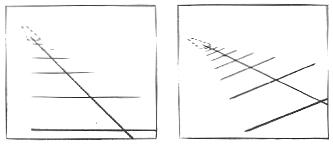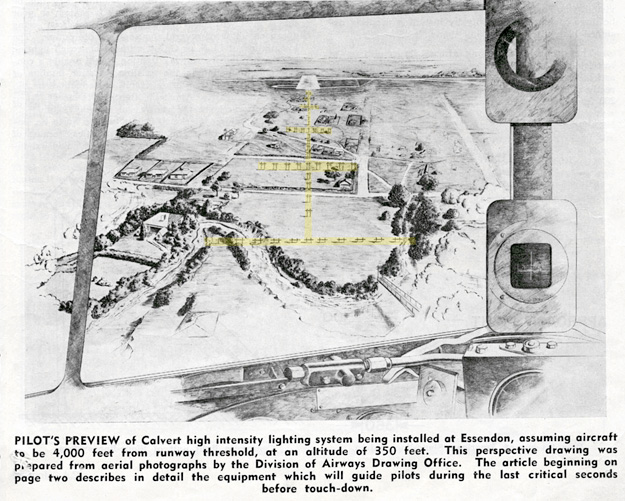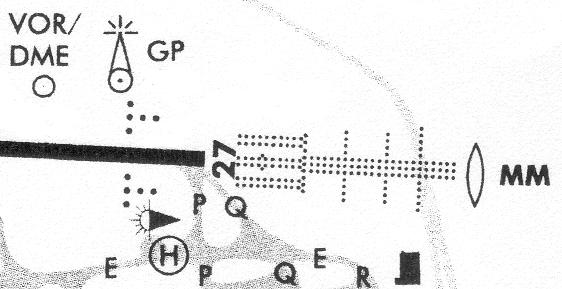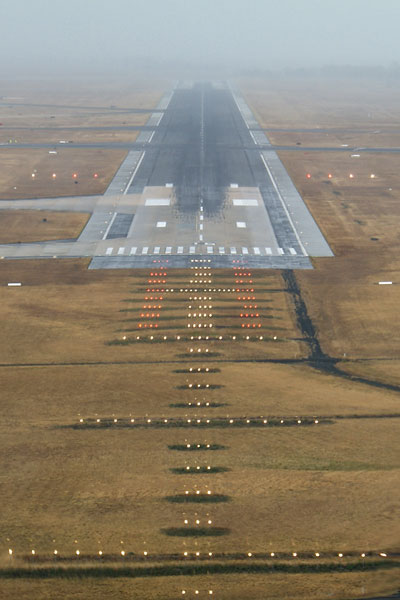
In the late
1940s the problems of transition from the new precision radio instrument approach
aids to the final, visual approach at night or in reduced visibiltiy much exercised
civil aviation. Various high-intensity approach lighting systems were developed
to ease the transition from instrument to visual flight. In 1949 three competing
systems - a British one (the Calvert system), a French one (a form of displaced
Calvert system) and an American one (the Slope Line system) were presented to
ICAO. Because each system had its supporters among the ICAO members, ICAO ended
up recommending that any of the three systems could be adopted. Independently,
and before the ICAO decision, DCA engineers had also been sudying the problem
of approach lighting and had concluded that the British 'Calvert' system was superior.
A trial installation was installed on Melbourne/Essendon's Runway 26 toward the end of 1951.
This trial proved successful and the system was commissioned for operational use
in 1953.
The photo above shows the Calvert High Intensity Approach Lights on Essendon's Runway 26 shortly after they were commissioned. Being a time exposure, the lights of aircraft landing are shown as long streaks terminating at the runway threshold. This photo also gives a good impression of the positioning of the lights among the houses of the suburb of Strathmore. The photo was taken from Gaffney Street looking across the Moonee Ponds Creek valley.

The following information about the Calvert cross bar lighting system is based on an article High Intensity Approach Lighting by S.W. Hart (DCA Sectional Airways Engineer) which appeared in the Civil Aviation Jounal, the DCA's house publication, Vol 1, No 3, March 1951.
In 1946 Mr E.S. Calvert of the Royal Aircraft Establishment, Farnborough, UK, was requested by a UK Ministry of Civil Aviation Airfield Lighting Committee to investigate the problem of approach lighting and establish the general principles involved. Calvert tackled the problem by attempting to ascertain the visual and mental processes by which a pilot lands an aircraft. He then developed a theoretical model by which different lighting systems could be compared, and tested his theoretical results using simulation.
Calvert's line of reasoning led him to the conclusion that to provide smooth transition from instrument to visual flying without optical illusions, and to provide sensitive and natural indications which could easily be interpreted by the average pilot, the approach lighting pattern should consist of a centre line of light with horizontal bars of light running transversely across it at even intervals. This pattern consists of two basic elements - a line of lights leading to the runway threshold, and horizontal lights to define the attitude of the aircraft. Calvert placed much stress on roll guidance compared with the Americans who, up to that time, had completely neglected it. He was the first to realise that it was easy to confuse lateral displacement with angle of bank.
The Calvert system does not indicate a defined glide path, but the widths of the horizon bars are such that, if a pilot maintains a glide that will take him to the correct touch down point, each bar will appear to be the same width as the previous one as it disappears under the nose of the aircraft. Distance is indicated by using single lights in the centre line to indicate 1000 ft or less from the threshold, double lights for 1000-2000 ft and triple lights for 2000-3000 ft.
The basic form of the Calvert cross bar lighting system still forms the basis for high-intensity approach lighting systems today.


Diagrams
above: With horizon bars the pilot can see if he is on an even keel but offset from the centreline (left) or
banked right wing down to turn on to the centreline (right). The photograph shows the Calvert system at Alice Springs - click on the image for a larger version.
The illustration below is from the March 1951 issue of the Civil Aviation Journal and shows what pilots could expect to see from the newly-installed Calvert system at Melbourne/Essendon. The lighting array has been highlighted for clarity.

Below:
A modified form of the basic High Intensity Approach Lighting system is used on
precision approach (ILS) runways, in this case on Melbourne/Tullamarine's
Runway 27. The main difference is the larger array of lights just prior to the
threshold.


< The image at left shows the ILS Cat III Calvert High Intensity Approach Light (HIAL) array on Melbourne/Tullamarine's Runway 16. The wing bars are very prominent, as is the red and white dense array marking the imminent approach to the runway threshold.
Note also the PAPI system either side of the touchdown point, with two red and two white lights on each side indicating 'on slope'.
This photo was taken on 5 March 2009 after an approach with a ceiling just above the ILS minimum.
Roll your cursor over the image to get a night-time view of the same lighitng system taken on 31 March 1978 - thirty one years earlier!
The major difference is the T-VASIS visual approach slope guidance system rather than PAPI in the daytime photo. The T-VASIS is showing 3 lights 'fly up', indicating the aircraft is well below the correct glideslope.
Also prominent are the green threshold lights, the white runway edge lights and the white inset touchdown zone lights that together go to make up the complete lighting system for a precision approach runway.
The image below shows a current view of the Runway 16 HIAL and precision approach runway lighting system at Melbourne. The photo was taken from a Boeing 717 on 24 August 2017.

(Photo top: CAHS/Wolfgang Sievers; Bottom 2-Phil Vabre/CAHS collection)
Click here to return to the main Communications & Navigation index
Click here to return to the main Airports & Aerodromes index
If this page appears appears without menu bars at top and left, click here